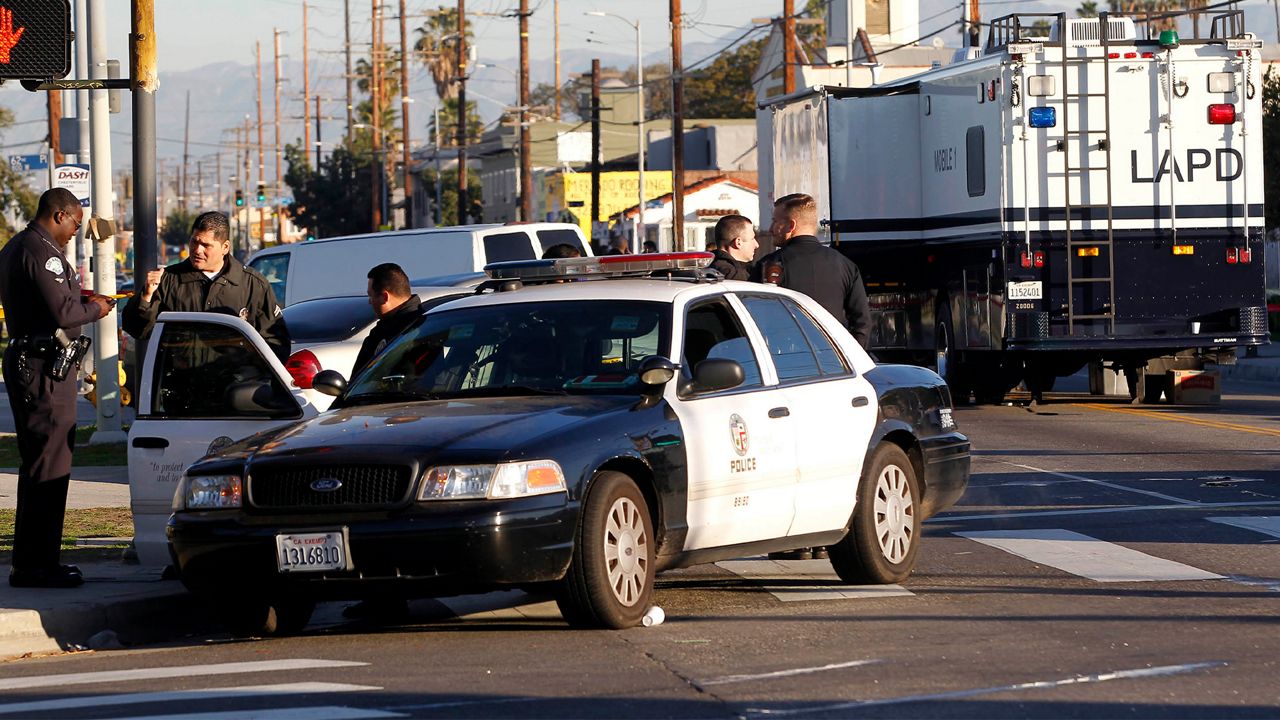(Akiit.com) A year ago, I asked this question: Why does the LAPD have to send waves of officers to calls in South L.A. no matter how seemingly trivial the complaint? A year later, I still ask that question. Here’s the latest case in point. On Monday, May 17, I approach the intersection of a side street near Slauson and Crenshaw. It is nearly blocked off. There are multiple LAPD cruisers and a small platoon of officers hovering on the sidewalk at the intersection.
There was no bank nearby, so there wasn’t a bank robbery in progress or a hostage siege. There was no mass of marching, jeering, object-tossing demonstrators nearby. There was no apparent injured party standing or laying on the sidewalk. And there was absolutely no indication there was any gunplay. Then what brought the cavalry to the scene?
There was one young man standing with his face to a home, in handcuffs. He was not resisting. He had no weapon. Yet he was surrounded by a horde of officers. I’ve seen this scene so many times in South L.A. I can mail it in and recite it in my sleep. A young Black man in cuffs is surrounded by a throng of cops. I have yet to see anything remotely like this scene—an arrest, with multiple officers standing around, in West L.A., Westwood, or Sherman Oaks.

How to explain the quasi-military overkill of hordes of cops at the scene for no heavy-duty violent or major crime in evidence on South L.A. streets? Is it a case of too many cops with too much time on their hands, and who use every arrest, no matter how routine and picayune, as an excuse to socialize with other officers? I often get that distinct impression.
Or could it be that there are way too many officers on way too many streets in South L.A.? Namely, the ancient complaint that South L.A., as all other poor, Black, and Hispanic inner-city neighborhoods, is vastly overpoliced. And the LAPD, as other police departments in similar neighborhoods, operate as something akin to a big, aggressive, standing army in South L.A.
Now, the longtime buzz words with the LAPD brass in relation to policing in South L.A is a partnership, and community policing. Meaning that the LAPD no longer operates as an occupying almost paramilitary army. The old Us versus Them has been the ancient knock against the LAPD. Partnership supposedly puts prime emphasis on dialogue with Black leaders, activists, and community residents, and acting as a service agency; all done with a kinder, gentler face.
Mayor Garcetti and Los Angeles Police Chief Michel Moore repeatedly make that point. In short, they are firmly on the path to doing what police reformers have been demanding for decades. Namely, police South L.A. the same way you police West L.A.
Yet, compare the dual standard of policing routinely reserved for low income Black and Hispanic inner-city neighborhoods versus that for middle- and upper-income white suburbs. In one, the police procedure is massive shows of force, dubious stops, searches, racial profiling and gruff commands and orders.
In the other (unless the person stopped, searched, and profiled happens to be a young African American walking or driving through those cities), the police procedure is Mr. Rogers-type courtesy, friendly dialogue with emphasis always on protecting citizens, safeguarding their rights, and providing full public service.
Post George Floyd, the LAPD and most other big city police officials pay lip service to community policing and reform. However, the streets in South L.A. still tell a far different story. The over-policing in inner city neighborhoods has been well documented in countless studies. The most recent being by the John Jay College of Criminal Justice, Data Collaborative for Justice, a criminal justice reform group. The study found African Americans had an enforcement rate nearly double that of Hispanics, and a whopping six times higher than whites. Put bluntly, Blacks are six times more likely to be stopped, searched, and subject to arrest than whites.
The standard retort is that South L.A. and other poor Black neighborhoods have higher crime rates. And residents scream for more, not fewer, police. The problem with both assertions is that claiming more crime among Blacks is both a numbers game and a self-fulfilling prophecy. You put more cops in a neighborhood, the result is not the revelation of the ages. You ‘re going to have more arrests, and thus a skewed picture by the numbers solely, of more crime. As for Blacks demanding more police. The demand is not for vast armies of cops prowling the streets. But policing that stresses providing service, assistance, and a sensitive response when there is need.
Since Rodney King, the LAPD has revamped many of its policies and procedures on everything from the use of deadly force to racial profiling. A major effort has been made to make the department look like the citizens it polices in L.A.
Those changes are much needed and welcome. However, the LAPD’s gross overreaction to the many scenes I witness in South L.A. stand in stark contrast to what I see when police make stops in other areas.
The message to the LAPD. You don’t need the cavalry charging in on every call you get in South L.A.
Columnist; Earl Ofari Hutchinson
One can visit this brother online over at; TheHutchinson Report.









Leave a Reply